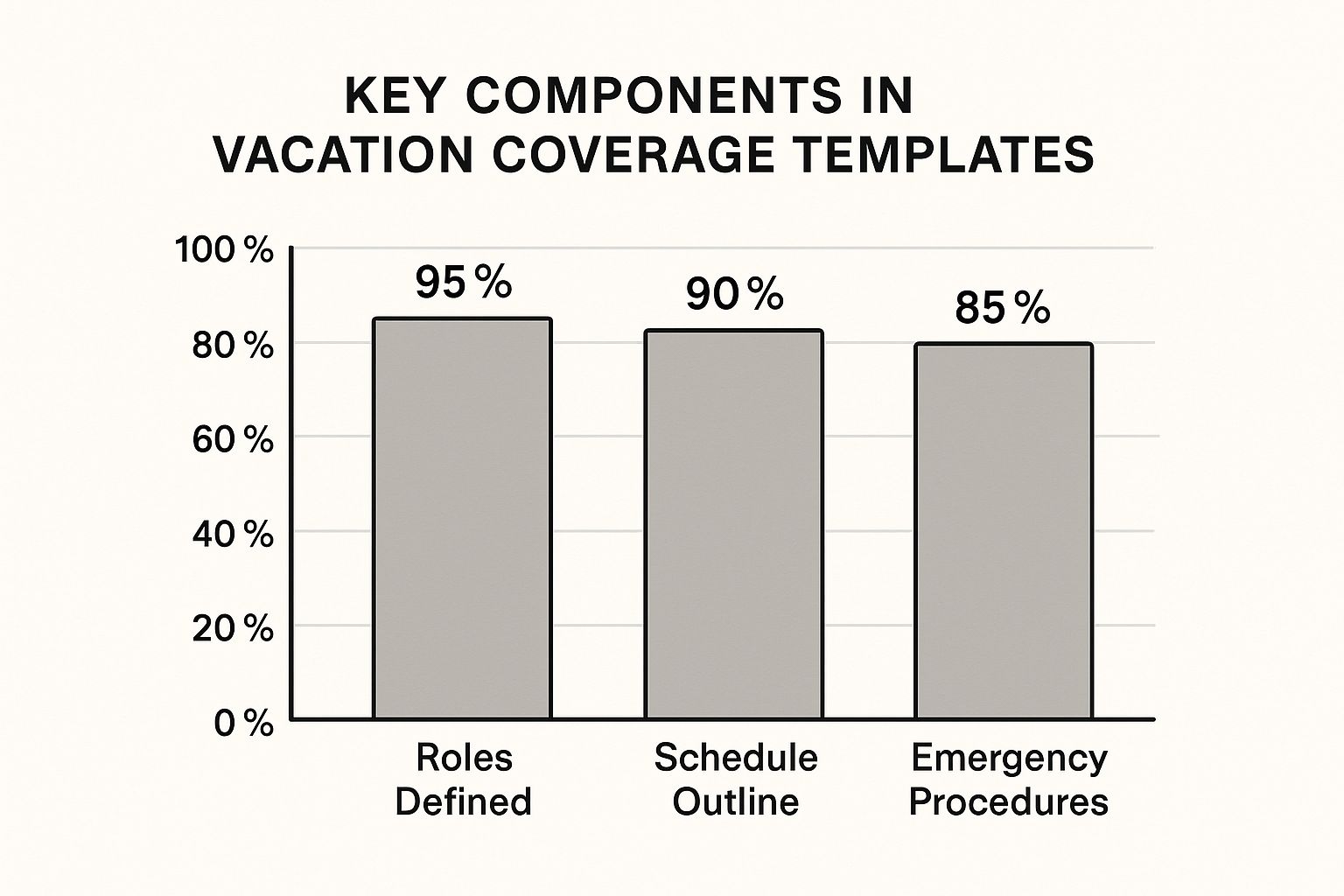Why Smart Teams Need Vacation Coverage Plans

Does a familiar wave of panic wash over your team when a key member announces their vacation? This reaction signifies a potential operational gap. Without a vacation coverage plan, teams often scramble reactively, leading to missed deadlines and frustrated clients. This not only impacts immediate productivity but also erodes team morale and creates instability. A well-defined plan can transform this potential disruption into a smooth transition.
Instead of fire-fighting, teams can maintain momentum. A vacation coverage plan template allows organizations to proactively address absences. This shift from reactive to proactive management creates a foundation for consistent productivity. Establishing clear responsibilities and workflows in advance prevents the confusion and delays often associated with unplanned absences.
The Benefits of Proactive Planning
Proactive vacation coverage planning offers numerous advantages:
- Improved Productivity: Continuous workflow, even during absences, helps maintain output and meet deadlines.
- Reduced Stress: Knowing tasks are covered reduces anxiety for both the vacationing employee and the remaining team members.
- Increased Team Satisfaction: A clear plan empowers team members and fosters shared responsibility.
- Enhanced Client Relationships: Consistent service, regardless of individual absences, builds trust and reinforces professionalism.
Consider a sales team without a coverage plan. A key account manager goes on vacation, and crucial client communications slip through the cracks. This can result in lost opportunities and damaged relationships. With a plan in place, another team member seamlessly steps in, maintaining client contact and ensuring a consistent experience.
This is crucial in today’s competitive market, where client relationships are essential. As travel costs rise, the need for comprehensive vacation coverage plans is further amplified. The average trip cost is projected to be $7,249 in 2025, a 24% increase from 2024. This underscores the importance of protecting both business operations and employee well-being. More detailed statistics are available here: Insights on Rising Travel Costs
Building a Culture of Preparedness
Implementing a vacation coverage plan template goes beyond simply checking a box; it builds a culture of preparedness and shared responsibility. It signals respect for employees’ time off while ensuring the organization functions effectively. By investing in a structured approach to absence management, organizations foster a more resilient, productive, and satisfied team. A well-executed vacation coverage plan is an investment in the organization’s long-term health and success.
Essential Components That Make Coverage Plans Work
What separates a successful vacation coverage plan from one that descends into chaos? The key lies in the essential components integrated into its structure. These elements ensure smooth operations, even when key team members are out.
Defining Roles and Responsibilities
A robust vacation coverage plan template must clearly define roles and responsibilities. This means specifying who is responsible for which tasks during an employee’s absence. Imagine a marketing team where the social media manager goes on vacation without assigning coverage. Scheduled posts get missed, and engagement plummets. Clear role definition prevents this.
It ensures everyone understands their responsibilities, eliminating ambiguity and preventing critical tasks from being overlooked. This clarity empowers team members to confidently manage their assigned tasks.
Outlining Schedules and Tasks
A detailed schedule outline is crucial. This includes not only when coverage is needed but also a specific breakdown of tasks. For example, a customer service representative’s coverage plan might include responding to emails, handling phone calls, and processing returns.
A detailed task list ensures nothing is forgotten. This granular approach transforms a general handover into a specific action plan.
Emergency Procedures and System Access
A critical, often overlooked, component is including emergency procedures. This section should detail how to handle unexpected situations. This could include contacting the vacationing employee, escalating issues to a manager, or activating a backup plan.
The plan must also include system access information. Without access to necessary systems, a covering employee can’t function effectively. This means documenting login credentials, software permissions, and any relevant access codes.

The infographic above shows the inclusion rate of key components in vacation coverage plan templates. Role definition and schedule outlines are common, while emergency procedures are often neglected. This highlights a potential weakness in many existing plans.
Delegation and Handoff Instructions
Clear delegation instructions bridge planning and execution. This template section should provide step-by-step instructions for handling tasks. This might include links to relevant documents, contact information for key stakeholders, or specific procedures for using particular software.
Think of it as a user manual for covering a colleague’s work. Proper delegation makes the handoff process smooth. This benefits the covering employee and provides peace of mind to the vacationing team member.
Return Transition Plan
A return transition plan minimizes post-vacation confusion. This section outlines how the returning employee gets back up to speed. It might include a debriefing with covering colleagues, a review of completed tasks, and a process for handling pending items.
This ensures a smooth re-entry and prevents the returning employee from feeling overwhelmed.
To help you build a robust vacation coverage plan, we’ve provided a detailed template below.
A well-structured template is essential for organizing coverage effectively. It ensures consistency and helps teams anticipate potential challenges. This template provides a framework for assigning responsibilities, outlining tasks, and managing transitions.
The following table outlines the key elements of a successful vacation coverage plan template:
Vacation Coverage Plan Template Elements
| Template Component | Purpose | Implementation Tips | Common Mistakes to Avoid |
|---|---|---|---|
| Role Definition | Clarifies who is responsible for specific tasks during an employee’s absence. | Use a role-based approach to define responsibilities, rather than assigning tasks to individuals. | Not clearly defining responsibilities, leading to confusion and missed tasks. |
| Schedule Outline | Specifies the timeframe for coverage and lists the tasks to be performed. | Include specific dates and times for coverage, as well as detailed task descriptions. | Providing a general overview without specific task breakdowns. |
| Emergency Procedures | Outlines how to handle unexpected situations that may arise during an employee’s absence. | Include contact information for the vacationing employee and escalation paths for critical issues. | Failing to include emergency contact information or escalation procedures. |
| System Access | Provides necessary login credentials and access codes for relevant systems. | Use a secure method for storing and sharing credentials. | Not providing access to necessary systems, hindering the covering employee’s ability to perform their duties. |
| Delegation Instructions | Offers step-by-step guidance on how to execute assigned tasks. | Include links to relevant documents, contact information for key stakeholders, and specific software procedures. | Providing vague instructions or failing to provide necessary resources. |
| Return Transition Plan | Outlines the process for the returning employee to get back up to speed. | Schedule a debriefing meeting and provide a summary of completed tasks and pending items. | Not having a plan for the returning employee, leading to a disorganized and overwhelming re-entry. |
By using this template, you can create a comprehensive vacation coverage plan. This proactive approach ensures continuous productivity and contributes to a positive work environment.
By incorporating these key elements, you create a vacation coverage plan template that supports your team and ensures continuous productivity. This proactive approach safeguards operations and creates a positive work environment where employees feel supported.
Building Your Custom Vacation Coverage Template

Generic vacation coverage templates often miss the mark when it comes to a team’s specific needs. This guide walks you through building a vacation coverage plan template tailored to your organization. We’ll begin by examining your existing workflows to understand your true coverage requirements, going beyond simply listing tasks. This practical approach ensures your template addresses real-world operational needs.
Conducting a Workflow Analysis
Before you start creating your template, a comprehensive workflow analysis is essential. This means mapping out all your crucial processes and identifying the key people involved in each. For instance, if your sales team uses a CRM like Salesforce, your workflow analysis should detail who uses it, what they use it for, and how frequently. This helps uncover dependencies and potential roadblocks when people are out. Understanding these dependencies forms the foundation of effective coverage planning.
Structuring Your Template: Universal and Role-Specific Elements
A good vacation coverage plan template blends universal elements with role-specific details. Universal elements, applicable across the board, could include employee contact information, vacation dates, and emergency contact details.
However, the day-to-day responsibilities of a sales representative are quite different from those of a software developer. That’s why role-specific components are needed to customize the template for each position. This ensures every critical task is accounted for.
Implementation and Integration: From Word Docs to Project Management Platforms
Many successful operations teams start with familiar tools like Microsoft Word and Google Docs to implement their vacation coverage templates. They offer a simple and accessible starting point.
However, consider integrating your template with your project management or HR platforms for added benefits. Platforms like Asana or Monday.com can streamline workflows and centralize important information. This easier access encourages consistency and reduces administrative burden.
Furthermore, think beyond traditional spreadsheets for managing workflows. Specialized software solutions might be a better fit for your specific needs. The growing demand for personalized planning, evident in the increasing popularity of customized travel insurance, underscores the need for adaptable solutions. To learn more, explore this topic further. This trend highlights the value of tailored solutions for unique requirements.
Balancing Comprehensiveness and Simplicity
While it’s important to be thorough, avoid creating a document that’s overly complicated. A user-friendly template encourages adoption across different departments. A clear and concise format makes it easy to update and access essential information. Strive for a balance between detail and usability. This encourages widespread use and turns your template into a valuable tool for everyone.
Rolling Out Your Coverage Plan Across Teams

A well-crafted vacation coverage plan template is essential, but its true value lies in effective implementation. This section explores how to seamlessly integrate your template into your team’s operations, transforming it from a static document into an active, operational standard.
Gaining Buy-In: From Leadership to Team Members
Successful implementation hinges on securing buy-in from all stakeholders. Begin by communicating the plan’s advantages to leadership. Emphasize how it boosts productivity, minimizes stress, and safeguards the organization from potential disruptions. For instance, illustrate how the plan maintains consistent client service levels, even during peak vacation periods. This strengthens leadership support for the initiative.
Engage team members by explaining the direct benefits they receive. Focus on how the plan reduces workload stress and promotes a better work-life balance. This encourages active participation and a sense of ownership.
Training and Understanding: Moving Beyond Compliance
Training should be more than just a perfunctory exercise. Instead, cultivate a genuine understanding of the plan’s universal benefits. Organize workshops where team members can practice using the template and address any questions they may have. This hands-on approach fosters engagement and ensures proper utilization.
When developing your template, explore alternatives to traditional spreadsheet software. Consider dedicated software solutions for managing workflows to improve efficiency and simplify the process.
Streamlining Workflows: Deadlines, Approvals, and Resistance
Establish clear deadlines for submitting vacation coverage plans. This provides ample time for review and necessary adjustments. Implement an approval workflow that balances oversight with efficiency, ensuring timely reviews without creating unnecessary bottlenecks.
Proactively address any resistance to the new plan. Openly discuss concerns and reiterate the plan’s benefits. This collaborative approach fosters understanding and minimizes pushback.
Adapting to Different Organizational Cultures
Recognize that each organizational culture calls for a tailored approach. A formal, centralized system may suit a structured corporate environment, while a decentralized approach may be more effective for a flexible team setting. Adapting your implementation strategy to your organization’s unique culture ensures a smooth transition and encourages widespread adoption.
Overcoming Implementation Hurdles
Implementation challenges are unavoidable. Anticipate potential roadblocks like initial resistance to change or difficulties integrating the plan with existing workflows. Address these proactively through clear communication, thorough training, and ongoing support. This ensures long-term success and transforms potential obstacles into opportunities for improvement. By focusing on these key elements, organizations can effectively implement their vacation coverage plan, creating a more resilient and productive work environment.
Elevating Coverage Plans With Strategic Best Practices
A solid vacation coverage plan template is essential for smooth operations. However, truly effective organizations go further. They use strategic best practices to turn vacation coverage into a tool for team growth and increased resilience.
Cross-Training and Knowledge Sharing
Savvy teams see absences as chances for cross-training. When team members cover for each other, they develop new skills and understand the workflow better. This builds a more flexible and adaptable team.
This cross-training also encourages shared responsibility. Furthermore, using knowledge-sharing protocols, like detailed documentation and regular knowledge transfer sessions, limits information silos. This organized approach reduces vulnerabilities and disruptions.
Rotation Systems and Expanding Team Capabilities
Instead of always relying on the same people for coverage, consider a rotation system. This distributes the responsibility fairly, preventing burnout and ensuring everyone benefits from cross-training.
Rotating coverage not only builds a stronger team but also helps employee development. It exposes individuals to new challenges and learning opportunities, creating a more collaborative and dynamic environment.
Handling Complex Scenarios: Overlapping Vacations and Critical Periods
Sometimes, multiple team members will be absent at once, or absences will fall during crucial times. Clear protocols for these situations are vital.
These protocols might involve prioritizing vacation requests, creating a flexible staffing pool, or having contingency plans for key tasks. Addressing these challenges proactively helps maintain smooth operations. For instance, temporary staff can support the team during peak periods.
Popular 2025 travel destinations tend to be safe places with good tourism infrastructure. Canada, for example, is gaining popularity due to its safety and scenery, while Europe remains a favorite. These trends highlight the need for strong vacation coverage, especially during busy business periods. Learn more: 2025 Summer Travel Insights
Workload Balancing and Realistic Expectations
Avoid burnout in covering employees by balancing workloads effectively. When implementing your coverage plan, consider the guidance found in this article on Managing Remote Teams. Clearly outline expectations for covering employees and provide ample support.
Realistic expectations are crucial. Recognize that covering colleagues while handling existing work requires extra effort. Acknowledging and appreciating this effort maintains morale and prevents resentment.
Leveraging Automation: Minimizing Manual Handoffs
Automation tools can greatly reduce the administrative work of vacation coverage. Automating tasks like email forwarding, task reassignment, and notifications streamlines handoffs and minimizes errors.
Tools like Jira‘s Out of Office Assistant automatically reassign tasks and approvals when absences are scheduled, integrating with current systems. This frees up team members to focus on their primary responsibilities, improving efficiency and creating a smoother workflow. Implementing these best practices transforms vacation coverage plans from basic task management into a strategic asset, fostering a more resilient, adaptable, and productive team.
Solving Common Coverage Challenges Before They Happen
A well-defined vacation coverage plan template is essential for smooth operations. However, even the best templates can’t prevent every challenge. Proactive organizations anticipate and address potential issues before they impact workflow.
Knowledge Transfer Gaps
Incomplete knowledge transfer frequently causes problems. When team members begin their vacations without properly briefing their colleagues, crucial information can get lost. This leads to project delays, errors, and frustrated clients. Imagine a software developer going on vacation without explaining a critical, in-progress bug fix. The entire project could be delayed.
- Preventative Measure: Require thorough handover documentation within your vacation coverage plan template. This ensures consistent access to vital information.
- Quick Response: Implement a buddy system. Each team member should have a designated backup who is generally familiar with their responsibilities. This provides immediate support if knowledge gaps appear.
- Long-Term Strategy: Facilitate regular knowledge-sharing sessions within teams. This proactive measure minimizes the impact of individual absences.
Inadequate Process Documentation
Inadequate process documentation compounds knowledge transfer problems. When processes aren’t clearly documented, covering employees are left to guess, potentially leading to inconsistencies and errors. A poorly documented customer onboarding process, for instance, can result in confusion and a negative client experience.
- Preventative Measure: Create a central repository for all process documentation, providing a readily available resource for everyone.
- Quick Response: Establish a rapid response team to address process-related questions. This team can quickly clarify procedures and minimize disruption.
- Long-Term Strategy: Integrate process documentation updates into regular team meetings. This ensures your documentation stays current and relevant.
Miscommunication About Responsibilities
Even with a template in place, miscommunication can still occur. Overlapping responsibilities or unclear assignments create confusion, potentially leading to duplicated work or neglected tasks. If two team members believe the other is handling client communication, for example, important messages can be missed.
- Preventative Measure: Use a RACI matrix (Responsible, Accountable, Consulted, Informed) within the template to clearly define roles and responsibilities for each task.
- Quick Response: Implement daily check-in meetings during critical absences to keep everyone aligned and address any emerging confusion.
- Long-Term Strategy: Utilize project management software to assign and track tasks, promoting transparency and accountability.
System Access Problems
System access issues can significantly hinder a covering employee’s ability to perform their duties. Forgotten passwords, incorrect permissions, or a lack of access to essential software can halt productivity.
- Preventative Measure: Include system access information in the vacation coverage plan template to ensure all necessary login credentials are readily available.
- Quick Response: Designate an IT support contact specifically for access-related problems to facilitate rapid resolution.
- Long-Term Strategy: Implement single sign-on (SSO) and robust password management systems. This streamlines access and reduces security risks.
To illustrate these common challenges and their solutions, let’s look at the following table:
Vacation Coverage Challenges and Solutions
This table compares common challenges encountered during employee absences and offers practical solutions using a coverage plan template. It also suggests preventative measures to avoid these issues altogether.
| Challenge | Impact on Business | Solution Using Coverage Template | Preventative Measures |
|---|---|---|---|
| Knowledge Transfer Gaps | Project delays, errors, client frustration | Mandatory handover documentation | Buddy system, regular knowledge-sharing sessions |
| Inadequate Process Documentation | Inconsistent practices, errors | Centralized process documentation repository | Integrate documentation updates into team meetings |
| Miscommunication | Duplicated effort, neglected tasks | RACI matrix for clear roles and responsibilities | Daily check-ins during absences |
| System Access Problems | Blocked productivity | System access info within the template | Single sign-on (SSO), robust password management |
This table highlights the importance of a comprehensive coverage plan template and proactive strategies for addressing potential issues. By utilizing these solutions and preventative measures, businesses can minimize disruption and maintain productivity during employee absences.
By proactively addressing these common challenges, organizations can significantly improve their vacation coverage plans. These preventative measures and quick-response strategies transform potential disruptions into opportunities for process improvement, building more resilient teams capable of effectively managing absences.
Want to further optimize your team’s vacation coverage and eliminate manual handovers? Consider Out of Office Assistant for Jira Cloud. This app automates workflows during team absences, ensuring seamless task and approval reassignments. This powerful tool empowers teams to deliver faster and enjoy well-deserved breaks.
